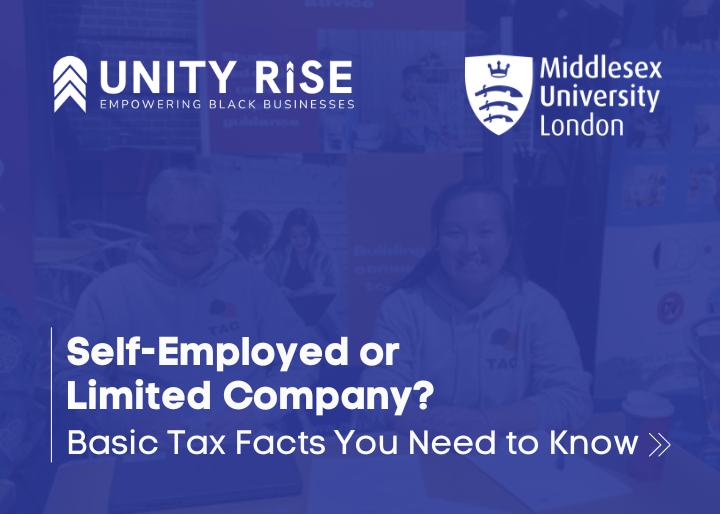This blog has been shared by Middlesex University Tax and Accounting Clinic (MDXTAC), who provide free, confidential support and advice to entrepreneurs. Shan Wang, MDXTAC Director, explains some foundational tax considerations for those deciding between self-employment and forming a limited company.
Starting a business is exciting, but it can also feel confusing. Common questions include: “Do I just register as self-employed?” “Have I missed a tax deadline?” “Does a limited company save me tax?” MDXTAC regularly supports entrepreneurs navigating these decisions. Here’s a simple guide to help you understand the tax implications of different business structures.
Self-Employed
Self-employment is the simplest and most common structure for small, start-up businesses. Registration is straightforward, administrative work is light, and you can take money from the business without formal cash extraction processes.
Tax obligations:
-
Income Tax and Class 4 National Insurance Contributions (NICs) are due on business profits.
-
From April 2026, businesses earning over £50,000 must submit quarterly returns under the Making Tax Digital initiative.
Income Tax (England and Wales, 2025/26)
| Band | Taxable income range | Rate |
|---|---|---|
| Personal Allowance | Up to £12,570 | 0% |
| Basic Rate | £12,571 – £50,270 | 20% |
| Higher Rate | £50,270 – £125,140 | 40% |
| Additional Rate | Over £125,140 | 45% |
National Insurance Contribution (England and Wales, 2025/26)
| Band | Profits Range | Rate |
|---|---|---|
| Lower Profits Limit | £0 to £12,570 | 0% |
| Main Rate | £12,571 – £50,270 | 6% |
| Upper Rate | Over £50,270 | 2% |
Illustrative Example: £50,000 Business Profits (2025/26)
| £ | £ | |
|---|---|---|
| Business Profits | 50,000 | |
| Less: Personal Allowance | -12,570 | |
| Taxable Income | 37,430 | |
| Less: Income Tax Deductions (20%) | -7,486 | |
| Less: Class 4 NICs | -2,246 | |
| Total Tax & NIC due | -9,732 | |
| Take-home amount | 40,268 |
Self-employment keeps things simple: your after-tax profit is effectively the money you can take home, but the right business structure depends on your income level, long-term goals, and appetite for administrative tasks.
Other considerations:
-
Personal Allowance reduction: If total income exceeds £100,000, the personal allowance (£12,570) is reduced by £1 for every £2 above this threshold and is fully lost at £125,140.
-
Marriage Allowance: If married or in a civil partnership, and the other partner earns less than £12,570, up to £1,260 of that allowance can be transferred to the higher-earning partner (if they are a basic rate taxpayer), saving up to £252 in tax per year.
-
Allowable Business Expenses: Business owners can deduct costs that are “wholly and exclusively” for business use. Non-business costs, such as drawings, personal spending, or fines, cannot be claimed.
-
Business losses: Relevant loss reliefs can be claimed when completing the tax return.
-
Other sources of income: If you have multiple sources of income, such as salary, rental, or savings, tax calculations will differ from the simple illustrative example provided, which is common for entrepreneurs starting a new business.
Private Limited Company
Running a business through a limited company is a different world from self-employment. The company is treated as a separate legal entity from the owner. That means:
- The company pays Corporation Tax on its profits.
- You, as a shareholder/director, then extract money via salary or dividends.
Corporation Tax in 2025/26
- 19% “Small profits rate” on company profits up to £50,000.
- 25% “main rate” on company profits over £250,000.
- Between £50,001 and £250,000, a tapered corporation tax rate applies.
Illustrative example: A private limited company, ABC Ltd, with £50,000 before-tax profit qualifies for the 19% small profits rate:
-
Corporation Tax due: £50,000 × 19% = £9,500
-
After-tax profit: £50,000 − £9,500 = £40,500
If the director takes the £40,500 as dividends in 2025/26 with no other income, the income tax liability is:
| £ | £ | |
|---|---|---|
| Dividends | 40,500 | |
| Less: Personal Allowance | -12,570 | |
| Taxable Income | 27,930 | |
| Less: Income Tax on Dividends | -2,400 | |
| Take-home amount | 38,100 |
There are no National Insurance Contributions on dividends. However, taking all profits as dividends may affect entitlement to certain state benefits, particularly the state retirement pension. It is generally advisable to take a combination of salary and dividends. While a limited company does not automatically reduce tax, it offers liability protection and opportunities for financial planning.
Filing and Administration Deadlines (2025/2026)
| Structure | Tax Return to HMRC | Payment Deadline to HMRC | Companies House Filing | Making Tax Digital (MTD) Rules |
|---|---|---|---|---|
| Self-Employment | Submit Self-Assessment by 31st January 2027 for tax year 2025/26 | 31st January 2026: 1st Payment on Account due
31st July 2026: 2nd Payment on Account due 31st January 2027: Balance of Income Tax and NIC due |
N/A | MTD for Income Tax: From April 2026 if turnover is more than £50,000 (quarterly digital submissions) |
| Limited Company | Company Tax Return (CT600) due 12 months after the financial year end | Corporation Tax due 9 months + 1 day after the financial year end | Annual accounts due to Companies House 9 months after the year end.
Confirmation Statement filed annually. |
No MTD |
Additional information:
-
Keep track of losses and reliefs.
-
Recordkeeping can start simple, but MTD will eventually require accounting software.
-
Free advice is available initially; accountants may be needed as the business grows.
-
Notify HMRC when you start trading.
-
Many small businesses start as self-employed and later transition to a limited company.
-
Plan cash flow early to meet Payment on Account deadlines.
-
Register for PAYE if paying yourself or staff.

About MDXTAC
Middlesex University Tax and Accounting Clinic (MDXTAC) offers free, confidential, and practical advice to entrepreneurs. Led by qualified chartered accountants, the clinic provides valuable work experience for final-year accounting students.
Contact MDXTAC for a friendly and confidential chat about your business structure, tax queries or if you just want to make sense of the numbers:
Email: tac@mdx.ac.uk
Website: https://www.mdxtac.org



